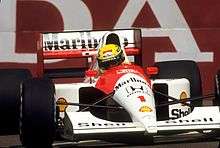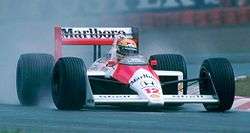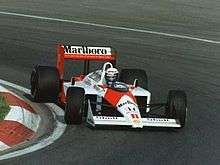Prost–Senna rivalry
The Senna–Prost rivalry was a Formula One rivalry between Brazilian racing driver, Ayrton Senna and French racing driver, Alain Prost. The rivalry was at its most intense during the period in which they were teammates at McLaren in the 1988 Formula One World Championship and the 1989 Formula One World Championship seasons. The rivalry continued on not only between the drivers but between manufacturers when Prost joined Ferrari in 1990.[1] The relationship between the drivers was as polarising as it was fierce, with confrontations between the drivers a regular occurrence.
As teammates, Senna and Prost won 25 of 32 races over the 1988 and 1989 seasons, signifying the pure dominance the drivers had over the competing field and other manufacturers. Senna had 14 victories and 26 pole positions whilst Prost had 11 victories and 4 pole positions. As opponents, Senna amassed 21 victories to Prost's 12. During the six-year period (1988–1993) in which the rivalry was active, Senna won 3 Formula One World Championships with Prost winning 2 Formula One World Championships over the same period, including a 1-year hiatus by Prost during the 1992 season.
History
The Senna–Prost rivalry is widely regarded as one of the fiercest rivalries in Formula One to date.[2] With both drivers considered some of the best to compete in the sport, Ayrton Senna and Alain Prost were at the forefront of fearless driving, with both having a relentless determination to win. Prost joined Niki Lauda at McLaren in 1984 winning his first championship in 1985 and again in 1986. It was Prost himself who convinced McLaren officials to sign Senna from Lotus Formula One in 1988. It was this point that the rivalry started, with Senna narrowly won the 1988 championship from Prost. The battle for supremacy between teammates came to head in the years to follow with allegations of preferential treatment and favouritism towards Senna ultimately leading to Prost signing for Ferrari in 1990.[3] This ultimately led to an intense manufacturer rivalry between McLaren and Ferrari.
Senna won the South American Kart Championship in 1977, with his success translating to the global karting arena, where he finished runner up in the 1979 and 1980 Karting World Championships. Senna would continue his surge to Formula in the corresponding years. Five years Senna's senior, Prost was born near the town of Saint-Chamond, close to the cities of Lyon and Saint-Etienne in France.[4] Leaving school in 1974 to become a full-time racing driver, Prost went on to win numerous domestic and world karting championships,[4] making his Formula 1 debut in 1980 for McLaren being run by Teddy Mayer.
Senna first came onto the Formula 1 scene through his outstanding performances in the British Formula 3 Championship in 1983. During this period, Williams, McLaren and Brabham all had Senna testing their cars. However, Senna failed to get a seat the following season with each of these teams, having to settle for a seat with Toleman who were into their fourth season and yet to complete a race higher than fourth place.[5] It wasn't until 1988 that the pair were both driving for a reinvigorated, extremely fast McLaren team, from which point the pair endured a tenacious rivalry.
Despite Prost already claiming two Formula One World Championships, the relentless nature of Senna's driving style often outperformed the methodical, calculated nature of Prost's style.[6] Their contrasting approaches to racing, in combination with both men having a dominant car, it was inevitable that there would be highly controversial moments on and off the track.[7] Throughout their time in Formula One Prost finished with 51 wins and 4 world championships. Senna, before his death in the 1994 San Marino Grand Prix had 41 wins and 3 world championships to his name.
Formula 1 teammates (1988–1989)
1988 Season
The 1988 pre-season was rife with speculation around who would win the championship and what the driver lineups would look like. It was announced that Ayrton Senna would join the McLaren-Honda Formula One Team, with Prost as his co-driver. Many expected Prost to dominate, however, the relentless nature of Senna and his knife-edge performances saw him win his first championship come seasons end.
The McLaren team dominated the season, with both their cars being far superior to the competing field. Winning 15 of the total 16 races Ferrari were the only team to beat McLaren during the season, with their one and only win coming at the 1988 Italian Grand Prix. McLaren won the constructors' championship with a then-record 199 points. Senna specifically had a poor start to the season, with gearbox failure ending his home Grand Prix – The 1988 Brazilian Grand Prix, with Prost taking out the victory. Senna recorded a total of 8 wins with 13 pole positions whilst Prost crossed the finish line first a total of 7 times with 2 pole positions to his name. These figures began to show Senna's single-lap dominance against Prost's calculated racing strategy.
Tensions arose towards the end of the season when Prost feared McLaren bosses were giving Senna preferential treatment. His fears were later proven correct through a meeting with the head of Honda's R&D department, Nobuhiko Kawamoto who had noted that the Japanese-based engine manufacturer had an affinity with Senna's "Samurai driving style".[4] Prost was later promised a more transparent team approach, favouring equality between the drivers, however this was not to be.
1989 Season
The 1989 season saw Alain Prost claim his third world championship and last with McLaren, with the team also taking the constructors' title for the second consecutive year. The championship was decided in highly controversial circumstances at the penultimate race meeting of the year; the 1989 Japanese Grand Prix. Senna, needing to win collided with Prost during final laps of the race, causing Prost to retire from the race, only for Senna to be disqualified after the race for re-entering the track incorrectly. This consequently handed Prost the title.
The 1989 season saw a host of regulation changes, the major of which was ending the turbocharger era in Formula 1.[8] A new, naturally aspirated 3.5 litre engine were to be used.[9] Despite Ferrari winning the 1989 Brazilian Grand Prix, McLaren-Honda continued their previous season form. Both Senna and Prost traded wins throughout the season, with the Ferrari's on some occasions managing to challenge the powerful V10 McLarens. The first cracks began to appear in the McLaren garage at the 1989 Monaco Grand Prix. Prost highlighted his discontent with Senna, resulting from an agreement in which whoever won the start off the line, would not be challenged into the race. Senna passed Prost on the first lap and went on to win by over a minute.[10] Marlboro's John Hogan was in support of Prost's proposed agreement, with Senna denying such an agreement was ever made.
By the 1989 Italian Grand Prix, Prost had made his intentions clear for the 1990 season, by signaling his move to Ferrari. Prost would go on to win the Italian GP after Senna's engine blew up while in the lead. Whilst on the podium, Prost threw his first-placed trophy into the below Ferrari-fanatic Tifosi much to the distaste and fury of Ron Dennis and McLaren officials. Senna struck back in the Spanish Grand Prix, blowing away the field yet again, however needed to win the remaining two races to ensure a second world championship.
The 1989 Japanese Grand Prix remains one of the most infamous races in Formula One history. Senna took pole position with Prost in second. Prost jumped Senna at the start and was leading into turn 1. Senna fell back and positions remained unchanged. On lap 46 out of 53, Senna, desperate to pass Prost to keep his championship hopes alive, tried to overtake the Frenchman at the last chicane but Prost closed the door and the two collided. Prost, claiming his innocence, was later found to have deliberately turn into Senna on television replays. Such is the relentless attitude of Senna, he waived the marshalls over for a push-start – within the rules if a car is deemed to be parked in a dangerous position. Senna re-entered the race via a run-off-road[11] made it back the pits for a new front wing, managing to re-take the lead in the final few laps, crossing the line first. A long period of silence ensued with podium regularities conducting without Senna. Senna was disqualified for re-entering the track illegally, ultimately quashing his chances for a second title. Senna made a case to the Fédération Internationale de l'Automobile (FIA), however his case was dismissed swiftly. Senna would continue to protest throughout the off-season, with his ultimate battle just beginning to heat up.
McLaren–Ferrari rivalry
1990 Season
The 1990 Formula One season signaled the beginning of an intense constructor rivalry between Ferrari and McLaren. With Senna still at the helm of his Honda-powered McLaren and Prost, newly seated in a Ferrari for the first time. Similar to the 1989 season, the championship came to its head at Suzuka. After Prost had mounted a significant title challenge in his Ferrari by claiming three consecutive mid-season wins at Mexico, France, and in the British Grand Prix. The championship would solely be between Senna and Prost for the third consecutive season. Senna, heading into the penultimate race of the calendar at Suzuka knew that any finish ahead of Prost, or if the pair were to crash out, he would be crowned world champion.
Senna, despite securing pole position was distressed with the inside line whereby the pole sitter starter was on the dirtier side of the track. Senna protested with FISA president Jean-Marie Balestre that pole position should start on the racing line, however Senna's pleas were ultimately rejected despite initial approval. An infuriated Senna vowed to attempt to take the lead no matter the cost heading into turn 1. Subsequently, Prost, starting on the clean side of the track jumped Senna. Heading into turn 1 Senna dived down the inside of Prost's Ferrari, colliding and taking both drivers down the gravel and out of the race. Senna was crowned champion. With Benetton flooding the podium, it meant that the McLaren-Honda team would win its 6th Formula One Constructors' Championship. In heated discussions post race, Prost revealed his disgust with Senna's tactics,[12] publicly slamming Senna as "disgusting....and a man without value" claiming he almost retired on the spot.[13]
1991 Season

Retaining their successful driver lineup from the 1990 season of Senna and Gerhard Berger, McLaren were in the box seat for the 1991 season. The 1991 season saw Senna take his third and final world driver's championship, with McLaren-Honda taking out their fourth constructors' championship. Despite previous seasons seeing Senna and Prost consistently battle for supremacy, it would be Britain's Nigel Mansell who would come closest to challenging Senna for the title. However, Senna would dominate the first four races of the season, effectively clinching the title before the half-way mark of the season.[14] Prost, despite his previous success was unable to win a grand prix in a calendar year for the first time since 1980.[15] Consequently, Ferrari struggled throughout the season, failing to come anywhere near the Mansell and Senna cars. The 1991 season also saw a number of rule changes with a win now worth 10 points, and every race result would count towards the championship compared to previous seasons, where the best 11 races were only counted.
With little competition throughout, Senna, with his consistent and relentless pace claimed the championship with 96 points to Mansell's 72. Prost was dropped from his seat for the final race of the season due to a strong falling out with Ferrari bosses, after he publicly criticised the Ferrari team.
1992–1993 seasons
The 1992 Formula One season saw the end of the dominant McLaren period, with William's Nigel Mansell becoming the first British driver since James Hunt to win a Formula One World Championship.[16] Despite managing three race wins, Senna could only manage fourth place in the driver standings come season's end. Prost took a year off from racing following his well-publicised falling out with Ferrari. The 1993 Formula One season saw Prost return to the grid and eventually taking out his fourth drivers' championship, with Senna a close second driving a Ford-powered McLaren. Prost championship win saw him signaling for retirement, with Senna seeking new pastures from his underperforming McLaren.
Formula 1 World Championship results as teammates
Summary
| Driver | Entries | WDCs | Wins | Poles | F/Laps | Podiums | Points |
|---|---|---|---|---|---|---|---|
| 32 | 1 | 14 | 26 | 6 | 18 | 150 | |
| 1 | 11 | 4 | 12 | 25 | 163 |
Complete results
| ||||||||||||||||||||||||||||||||||||
Legacy between the drivers
Forever known as one of, if not, the greatest Formula 1 rivalry,[19] Ayrton Senna and Alain Prost were two of the most powerful influences in motorsport to this day. With an insatiable pedigree for winning, and a relentless determination to win, Senna, to this day is widely regarded a once in a generation driver.[20] With blinding speed and a level of willpower far above that of his competitors Senna was considered to be the benchmark for drivers around the world. However, in a somewhat complementary regard, Alain Prost intense, tactical and methodical approach to racing saw him compete to the very end with Senna.[21] Prost, unlike any other driver was able to face a setback in the eye and turn into something as great as a race win. Prost exemplified a level of professionalism perhaps greater than Senna, recognising key moments on which to capitalise.


With Prost's career coming to close in 1993 season, the stage was set for Senna to stake his claim as the true greatest. However, as often is the case with such a dangerous and unforgiving sport such as Formula 1, Senna was cruelly denied the opportunity to grace his skill into the future. Killed in the early stages of the 1994 San Marino Grand Prix, Senna's Williams collided at high speed with a barrier at the infamous turn 4 "Tamburello" causing widespread grief and loss. With Prost regularly a presence on the grid and in the paddock, he of all people recognised the significance of Senna's passing.
Senna and Prost had reconciled their relationship, as seen via an onboard lap with Senna, who was quoted with saying "A special hello to our dear friend Alain. We all miss you, Alain."[22] Prost was touched by Senna's kind words. The pair had agreed to meet before Monaco to discuss safety and regulation changes in the sport.
See also
References
- Knapen, Alexandre (2018-05-01). "Ayrton Senna and the Ferrari Connection Part 4 : 1990". DriveTribe. Retrieved 2019-06-03.
- Folley, Malcolm (2009-05-07). Senna Versus Prost. Random House. ISBN 9781409061922.
- "Documentary | FilmNav". Retrieved 2019-06-03.
- "Alain Prost", Wikipedia, 2019-05-02, retrieved 2019-05-11
- "Google". www.google.com. Retrieved 2019-05-11.
- ET, 2015 at 12:52p (2015-03-06). "Flashback Friday: Video compares Senna, Prost driving styles". FOX Sports. Retrieved 2019-05-11.
- Sedgwick, David. The power and the glory : Senna, Prost and F1's golden era. Worthing, Sussex. ISBN 9781785313653. OCLC 1006302502.
- "1989 F1 World Championship". Motor Sport Magazine. 2017-07-03. Retrieved 2019-05-15.
- "1989 F1 World Championship". Motor Sport Magazine. 2017-07-03. Retrieved 2019-05-15.
- "Google". www.google.com. Retrieved 2019-05-15.
- "Google". www.google.com. Retrieved 2019-06-03.
- "Alain Prost Grand Prix Homepage - Suzuka Special Part 3". www.prostfan.com. Retrieved 2019-05-17.
- "Suzuka Special". www.prostfan.com. Retrieved 2019-05-17.
- "1991 F1 World Championship". Motor Sport Magazine. 2017-07-03. Retrieved 2019-05-31.
- "1991 F1 World Championship". Motor Sport Magazine. 2017-07-03. Retrieved 2019-05-31.
- "1992 Formula One World Championship", Wikipedia, 2019-05-12, retrieved 2019-06-03
- 1989 Formula One World Championship points tables, 1990 FIA Yearbook, white section, page 60
- Only the best 11 results counted towards the Drivers' Championship. Numbers without parentheses are championship points; numbers in parentheses are total points scored.
- Senna, Ayrton (2019-04-26). "Ayrton Senna and Alain Prost will be in Legends Edition of the F1 2019 game". Ayrton Senna. Retrieved 2019-06-03.
- "Formula 1's greatest drivers. Number 1: Ayrton Senna". 2012-11-20. Retrieved 2019-06-03.
- Spurgeon, Brad (2015-09-18). "A Driver's Greatness, in the Words of Others". The New York Times. ISSN 0362-4331. Retrieved 2019-06-03.
- Hamilton, Maurice. (1998). Frank Williams. London: Macmillan. ISBN 0333717163. OCLC 44154610.